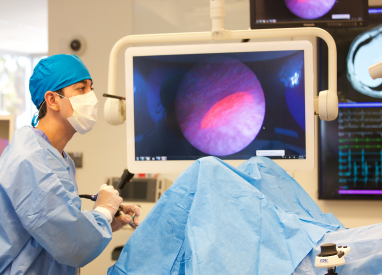Information on bladder cancer
What is bladder cancer?
Bladder cancer is an uncontrolled growth of abnormal cells in the bladder.1 The disease usually begins in the lining of the
bladder; however, cancerous cells may spread into the muscular wall of the bladder.1,2
Invasive bladder cancer may spread to:3
- Nearby or distant lymph nodes, other areas of the urinary system
- Organs in the pelvis
- Other organs in the body, such as the liver and lungs

What are common signs of bladder cancer?
Blood in the urine (hematuria) is the most common sign of bladder cancer.4,5
Other symptoms of bladder cancer include:4,5
- Irritation or pain during urination (dysuria)
- Urinating more frequently than usual
- Feeling the constant need to urinate
- Trouble urinating or having a weak urine stream
If you experience any of these symptoms, contact your doctor as soon as possible. There’s a high likelihood they are symptoms of a less severe condition, but don’t ignore them.4,5
How is bladder cancer diagnosed?

If signs and symptoms indicate bladder cancer, exams and tests will be needed to confirm diagnosis such as looking at medical history and performing urine tests to check for blood, infection and other abnormal cells.6

If bladder cancer is suspected, a urologist will perform a cystoscopy to look directly into the bladder.6,7

What is cystoscopy?
A cystoscopy is a procedure used to look directly into the bladder, using a thin, tube-like camera called a cystoscope. This procedure helps urologists examine the bladder so they can find the cause of symptoms and to treat conditions.7,8
If a urologist finds any abnormal growths or see suspicious areas, they may remove tissue samples (biopsy) and send them to the laboratory.7
A cystoscopy can be done while you are asleep under general anesthesia or while you are awake usually with local anaesthetic.8

References
1. American Cancer Society. What Is Bladder Cancer? 2022. Available at: https://www.cancer.org/cancer/types/bladder-cancer/about/what-is-bladder-cancer.html. Accessed March 2024. 2. Bladder Cancer Advocacy Network. What is Bladder Cancer? Available at: https://bcan.org. Accessed March 2024. 3. Healthline Media LLC. Does Bladder Cancer Spread Quickly? 2022. Available at: https://www.healthline.com/health/bladder-cancer/does-bladder-cancer-spread-quickly#types-that-spread. Accessed March 2024. 4. American Cancer Society. Bladder Cancer Signs and Symptoms. 2019. Available at: https://www.cancer.org/cancer/types/bladder-cancer/detection-diagnosis-staging/signs-and-symptoms.html. Accessed March 2024. 5. Bladder Cancer Advocacy Network. Signs and Symptoms of Bladder Cancer. Available at: https://bcan.org/facing-bladder-cancer/bladder-cancer-signs-symptoms. Accessed March 2024. 6. American Cancer Society. Bladder Cancer Early Detection, Diagnosis, and Staging. 2019. Available at: https://www.cancer.org/cancer/types/bladder-cancer/detection-diagnosis-staging.html. Accessed March 2024. 7. American Cancer Society. Cystoscopy. 2019. Available at: https://www.cancer.org/cancer/diagnosis-staging/tests/endoscopy/cystoscopy.html. Accessed March 2024. 8. Mayo Clinic Healthcare LLP. Cystoscopy. 2022. Available at: https://www.mayoclinic.org/tests-procedures/cystoscopy/about/pac-20393694. Accessed March 2024.

